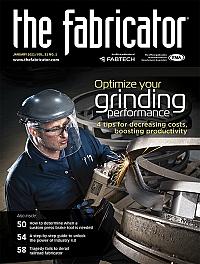Senior Editor
- FMA
- The Fabricator
- FABTECH
- Canadian Metalworking
Categories
- Additive Manufacturing
- Aluminum Welding
- Arc Welding
- Assembly and Joining
- Automation and Robotics
- Bending and Forming
- Consumables
- Cutting and Weld Prep
- Electric Vehicles
- En Español
- Finishing
- Hydroforming
- Laser Cutting
- Laser Welding
- Machining
- Manufacturing Software
- Materials Handling
- Metals/Materials
- Oxyfuel Cutting
- Plasma Cutting
- Power Tools
- Punching and Other Holemaking
- Roll Forming
- Safety
- Sawing
- Shearing
- Shop Management
- Testing and Measuring
- Tube and Pipe Fabrication
- Tube and Pipe Production
- Waterjet Cutting
Industry Directory
Webcasts
Podcasts
FAB 40
Advertise
Subscribe
Account Login
Search
Is an Amazon-like metal fabricator possible?
Industry 4.0 could help make that idea a reality in the metalworking industry
- By Tim Heston
- January 7, 2021
- Article
- Shop Management

Could the metal fabrication industry see a company as dominant as Amazon is in the retail business? It’s a possibility, especially if the vision of Industry 4.0 becomes reality. Getty Images
How did 2020, the worst year in recent memory, change us? No doubt, once a vaccine becomes widely available, we’ll gradually return to the world of face-to-face interaction with new appreciation. We won’t take each other for granted. But beyond the social sphere, how did 2020 change the way we interact with the economy? As we move on to do business in 2021, will we take some of 2020 with us?
2020 caused mammoth economic disruptions that left some flailing and others standing taller and stronger than ever. Those standing tall included, of course, Big Tech. It’s no wonder that many metal fabricators tied to the tech industry—such as those providing metal racking and hardware components as well as the structural steel for warehouse and data center construction—ended 2020 with record growth.
Those opportunities are the obvious ones, but 2020 also might have opened up subtler opportunities with greater long-term implications. It has to do with what Big Tech’s technology is making possible and, most critically, customers’ interest and willingness to explore and use that technology. The challenges of 2020 just might have accelerated that interest.
First, think about what exactly makes Big Tech companies so successful: They gather all (or nearly all) the customers in one place. Such a feat wouldn’t be possible without the internet, where alternatives are just a click away.Consider the most obvious example, Amazon. As it grew it offered consumers more and more choice, which in turn brought in more and more customers. Today Amazon’s power lies in the fact that it has gathered nearly all customers in one place. And with that power comes the ability to make incredible investments in servers, computing power, data analytics, and more, some of which fabricators benefited from in 2020.
Considering all this, what if the custom metal fabrication business had its own Amazon: a fabricator with all the customers in one place? In 2019 that notion seemed outlandish. Surely, I thought, the close relationship between a large sheet metal fabricator and an OEM wouldn’t fit that model.
Most job shops have a revenue mix that consists of a few top customers and a long tail of smaller ones. Certain fabricators—like the so-called “web shops” that have sprung up, particularly in Europe—have automated the quoting process to the point where they achieve tremendous revenue built on literally thousands of one-off and small-quantity orders from thousands of customers.
247TailorSteel, based in the Netherlands, is a prime example. Its customers upload a 3D solid model, receive a quote, and click “order.” With that click, the order is processed and scheduled automatically, and within hours one of 247TailorSteel’s laser cutting machines processes the part. Stateside, SendCutSend—a fabricator based in Reno, Nev.—launched with a similar web shop model in mind, though initially on a smaller scale.
Still, what about the large-quantity, consistently ordered jobs that make up the majority of revenue at most contract metal fabricators? The relationship between a major OEM and a major supplier of fabricated products can be very tight. That OEM-fabricator relationship, far deeper than the transactional relationships of retail, reduces the inherent risk of one company being so dependent upon another. It also increases customer “stickiness”; with so many points of contact, customers can’t just leave for a competitor on a whim.
Moreover, many estimators in this business feel lucky when they get a clean 3D model, and the process of converting customer-provided job information into something that can be fabricated isn’t easy to automate. The need for reliable subcontracting—be it for heat treating, powder coating, or anything else—complicates matters even more. Before the pandemic, I would have assumed most of metal fabrication was just too different from direct-to-consumer retail. Beyond certain niches, an Amazon-like web shop seemed like it just wasn’t in the cards.
Now, though, I’m not so sure. First, the pandemic has made more of us feel comfortable doing business virtually. Second, the potential behind Industry 4.0 opens the possibility of “distributed” metal fabrication. Could artificial intelligence one day determine what can be fabricated and, most critically, when and where? If so, could this form the backbone of an Amazon-like metal fabricator?
Some fabricating equipment-makers envision a day when their machines are connected to an AI-driven engine that helps each—be it a laser cutting machine, a press brake, or a weld cell—do what it does more efficiently and reliably. If, say, something goes awry with a laser cutting head, the machine-maker’s AI engine would detect and mitigate the issue before it becomes a real problem. Some of this AI-based tech is already available, at least to some degree.
Now imagine such equipment being used in a connected fashion across the supply chain—be it at the steel service center, contract metal fabricator, or job shop—all working together to give companies the right fabricated part, subassembly, or fully assembled and packaged product, all delivered in the right quantity and at the right time.
The Amazon-like fabricator could have its own fabrication capacity, but it also could work with capacity from a host of fabrication partners, all connected in some fashion to Amazon Fabricator’s neural network. The more powerful and more intelligent that network becomes, the more dominant Amazon Fabricator could be, especially with a new generation of customers well-accustomed to clicking a mouse or tapping a screen to buy.
About the Author

Tim Heston
2135 Point Blvd
Elgin, IL 60123
815-381-1314
Tim Heston, The Fabricator's senior editor, has covered the metal fabrication industry since 1998, starting his career at the American Welding Society's Welding Journal. Since then he has covered the full range of metal fabrication processes, from stamping, bending, and cutting to grinding and polishing. He joined The Fabricator's staff in October 2007.
subscribe now

The Fabricator is North America's leading magazine for the metal forming and fabricating industry. The magazine delivers the news, technical articles, and case histories that enable fabricators to do their jobs more efficiently. The Fabricator has served the industry since 1970.
start your free subscription- Stay connected from anywhere

Easily access valuable industry resources now with full access to the digital edition of The Fabricator.

Easily access valuable industry resources now with full access to the digital edition of The Welder.

Easily access valuable industry resources now with full access to the digital edition of The Tube and Pipe Journal.
- Podcasting
- Podcast:
- The Fabricator Podcast
- Published:
- 04/16/2024
- Running Time:
- 63:29
In this episode of The Fabricator Podcast, Caleb Chamberlain, co-founder and CEO of OSH Cut, discusses his company’s...
- Industry Events
16th Annual Safety Conference
- April 30 - May 1, 2024
- Elgin,
Pipe and Tube Conference
- May 21 - 22, 2024
- Omaha, NE
World-Class Roll Forming Workshop
- June 5 - 6, 2024
- Louisville, KY
Advanced Laser Application Workshop
- June 25 - 27, 2024
- Novi, MI































